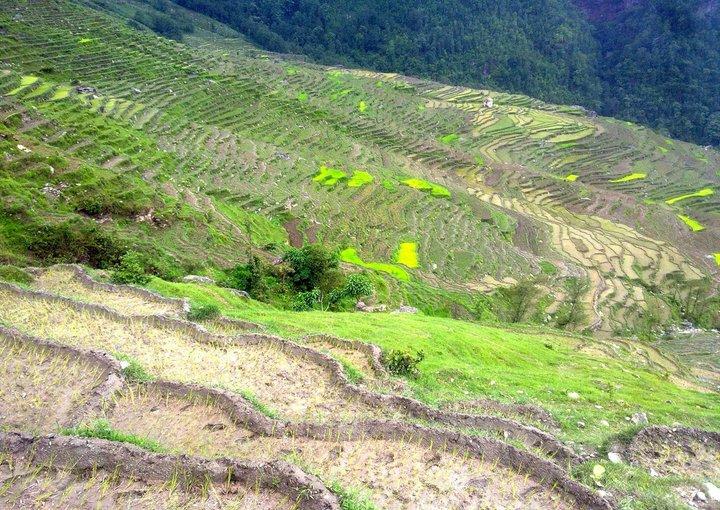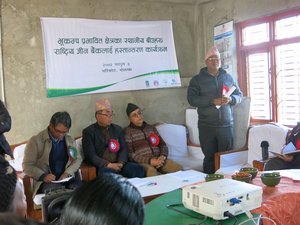Safeguarding native seeds and rebuilding local seed systems in the aftermath of the Nepal earthquakes

Almost a year after two earthquakes devastated parts of Nepal, find out how a Seed Recovery Programme in 10 of the 14 most-affected districts is working with farmers to rescue and safeguard rare native seeds that are essential for food security. Bhuwon Sthapit and Devendra Gauchan report.
Almost a year after two earthquakes devastated parts of Nepal, find out how a Seed Recovery Programme is working with farmers in 10 of the 14 most-affected districts to rescue and safeguard rare native seeds that are essential for food security in the remote mountainous regions. Bioversity International scientists Bhuwon Sthapit and Devendra Gauchan send their latest report from Nepal.
Almost one year ago, two earthquakes devastated parts of Nepal. Thousands of people were killed or injured, and over million people were left without water, food, shelter or medical assistance.
The most severely affected areas were the remote, mountainous parts of central and western Nepal, home to many remote communities completely dependent on smallholder agriculture for food and income. The earthquakes destroyed many of their farms and decimated winter crops of barley, legumes and maize that were ready to be harvested. Equally concerning for the longer-term food security for these people was the loss of many carefully stored seeds of traditional varieties – ones that have adapted over centuries to the harsh growing conditions in these remote areas and not easily replaceable.
Last summer, we reported on efforts by Bioversity International and partners to ensure that farmers in Nepal not only got the seeds they needed quickly, but that they were the right seeds – ones that can thrive in the challenging agro-ecological conditions and also meet local preferences, for example, as ingredients in traditional meals. But this is no easy task. Agricultural research programmes have not focused on these challenging and remote geographical areas, so there is little knowledge about the traditional crop varieties that grow there, and no back-up collections for these times of need.
 A Seed Recovery Programme is trying to address this need through collecting missions by farmers in the area to rescue and safeguard rare native seeds, and efforts to rebuild local seed systems in 10 of the 14 most-affected districts. The Bioversity International-led Programme is being implemented by LI-BIRD in three affected areas, with the technical support of the national genebank. This effort to work to rescue, multiply and safeguard these seeds is unique among activities by the post-disaster relief agencies working in Nepal.
A Seed Recovery Programme is trying to address this need through collecting missions by farmers in the area to rescue and safeguard rare native seeds, and efforts to rebuild local seed systems in 10 of the 14 most-affected districts. The Bioversity International-led Programme is being implemented by LI-BIRD in three affected areas, with the technical support of the national genebank. This effort to work to rescue, multiply and safeguard these seeds is unique among activities by the post-disaster relief agencies working in Nepal.
At the end of last month, the programme reached a milestone when seeds of rare and endangered crop species and varieties collected by farmers and field staff were handed over to the National Genebank at an event held at the District Agriculture Development Office (DADO), Charikot, in Dolakha.
These samples represent 446 local varieties of 46 different crops – 41% of which are considered rare. Most of the rare cultivars are traditional varieties of cereals (rice, maize, wheat, buckwheat, barley, and amaranth), grain legumes (beans, lentils, soybean, rice bean, sweetpea) and vegetables (chilli, radish, turnip, tomato, pumpkin, cucumber) that are important for local food and nutrition security.
 During the event, Ms Renuka Ghimire, a farmer and her team from Betali village, Ramechhap district displayed some rare local varieties of beans and soybean. Showing the local seeds to participants she explained that: “ We need to preserve them as these local varieties are pest-resistant, adapt well to drought conditions and meet the consumption preferences of farming families in our villages”.
During the event, Ms Renuka Ghimire, a farmer and her team from Betali village, Ramechhap district displayed some rare local varieties of beans and soybean. Showing the local seeds to participants she explained that: “ We need to preserve them as these local varieties are pest-resistant, adapt well to drought conditions and meet the consumption preferences of farming families in our villages”.
Mr. Prem Khatri, Programme Chair and Acting Chief of DADO, Dolakha, highlighted the importance of safeguarding native seeds in both the national genebank and community seedbanks as both a back-up measure for emergencies and also for the benefit of future generations: “Farm households are defacto genebanks for their native and rare seeds. I really appreciate the efforts of local farmers to conserve and maintain diverse local seeds of traditional crops even in the difficult situations such as during the aftermath of this recent disaster.”
Mr. Hikmat Kumar Shrestha, Chief of the District Agricultural Development Office Sindhuplanchowk and key stakeholder of the programme said: “Farmers’ varieties that are locally adapted are really important to strengthen local seed systems and ensure food security in the face of natural disasters and climate change”. He also recommended that national research and development agencies of the Nepal Government mainstream such activities.
 A farmer from Jugu Villag, Ms Makhana Khadka, shared her experience of how earthquake turned her home into rubble within a couple of minutes. However, through rescue collection efforts, she could recover some of her lost seeds that otherwise she would have no hope of getting back.
A farmer from Jugu Villag, Ms Makhana Khadka, shared her experience of how earthquake turned her home into rubble within a couple of minutes. However, through rescue collection efforts, she could recover some of her lost seeds that otherwise she would have no hope of getting back.
She brought for display several traditional crop varieties including a rare local variety of sweet buckwheat grown over generations in her village, that is adapted to the difficult terrain conditions where she farms. She described the buckwheat seeds as "important not only to our household food needs but also for local food recipes and the culture of the indigenous Jirel community." She added that “we have brought these seeds to safeguard for the future not only to meet food needs of our present generation but also to conserve our culture and traditions”. She was very happy to share the endangered seeds with other famers and people.
In addition to the Seed Rescue Programme, Bioversity International, in collaboration with partners, has spent the last few months working directly with farmers to select and test varieties taken from genebanks, plant breeding programmes and farmers’ fields. We have also been working to strengthen the capacity of experts engaged in variety evaluation and selection, to carry out rapid detection and dissemination of farmer-preferred varieties using crowdsourcing methods in areas affected by the earthquakes or at high risk of being affected in the future.
Bhuwon Sthapit and Devendra Gauchan
Read the earlier reports from Nepal
Part One: Matching seeds to needs in the aftermath of the Nepal Earthquake
Part Two: Deploying crowdsourcing and seed diversity in disaster recovery efforts in Nepal
Notes: The seed rescue collection for Seed Recovery Programme is implemented by the Local Initiative for Research and Development (LI-BIRD), in three districts with technical assistance from the national genebank. It is funded through the Genetic Resource Policy Initiative (GRPI)-Phase 2 project of Bioversity International in partnership with National Gene Bank, Nepal is also implementing the Seed Rescue collection for seed recovery in 7 other earthquake affected districts funded by Global Crop Diversity Trust. This work is also carried out through the CGIAR Research Program on Water, Land and Ecosystems.
Photos:
1. Agricultural landscape, Jugu, Dolakha, Nepal - one of the areas affected by the 2015 earthquakes. Credit: Pudasaini/LI-BIRD
2. Farmers handing over collected seeds. Credit: B. Dhewaju/LI-BIRD
3. Farmers from Ramechhap District display local varieties of crops at the handover event. Credit: D. Gauchan/Bioversity International
4. Chief of DADO Sinduplanchowk speaks at the handover event. Credit: P. Dhungana/Genebank
